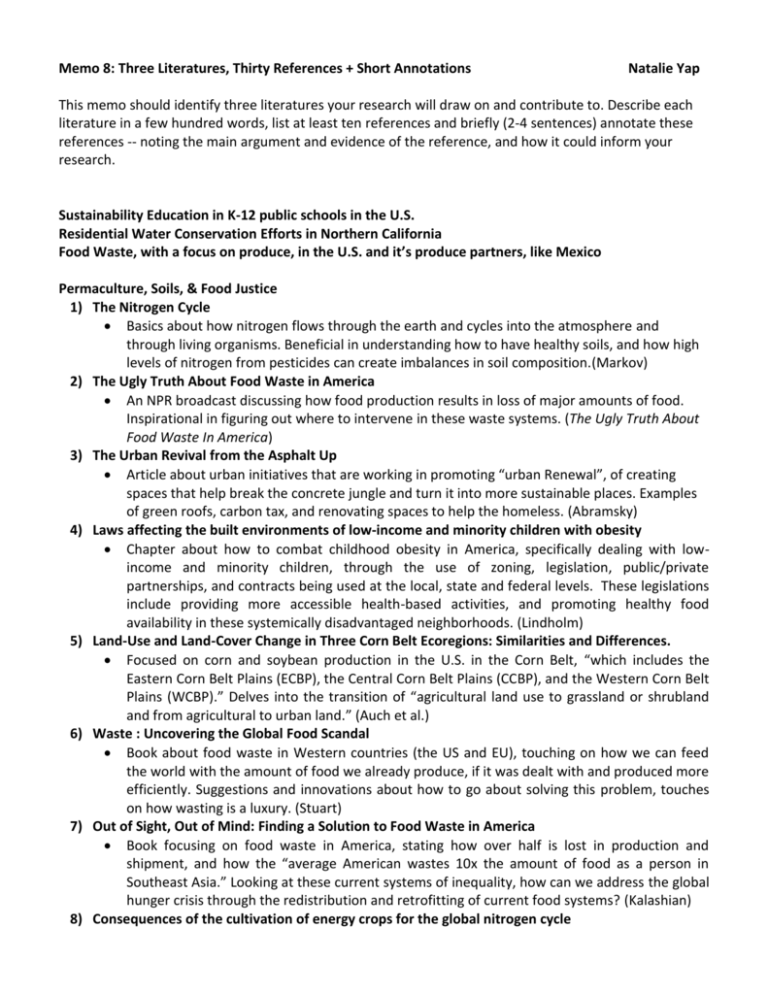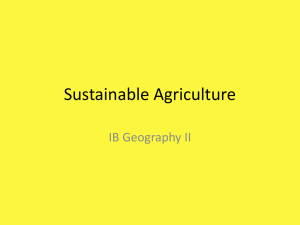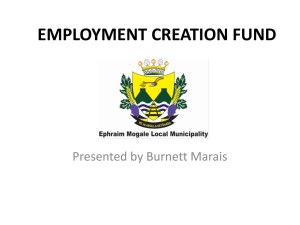Memo 8_3 literatures 30 referencesand short annotations_Natalie
advertisement

Memo 8: Three Literatures, Thirty References + Short Annotations Natalie Yap This memo should identify three literatures your research will draw on and contribute to. Describe each literature in a few hundred words, list at least ten references and briefly (2-4 sentences) annotate these references -- noting the main argument and evidence of the reference, and how it could inform your research. Sustainability Education in K-12 public schools in the U.S. Residential Water Conservation Efforts in Northern California Food Waste, with a focus on produce, in the U.S. and it’s produce partners, like Mexico Permaculture, Soils, & Food Justice 1) The Nitrogen Cycle Basics about how nitrogen flows through the earth and cycles into the atmosphere and through living organisms. Beneficial in understanding how to have healthy soils, and how high levels of nitrogen from pesticides can create imbalances in soil composition.(Markov) 2) The Ugly Truth About Food Waste in America An NPR broadcast discussing how food production results in loss of major amounts of food. Inspirational in figuring out where to intervene in these waste systems. (The Ugly Truth About Food Waste In America) 3) The Urban Revival from the Asphalt Up Article about urban initiatives that are working in promoting “urban Renewal”, of creating spaces that help break the concrete jungle and turn it into more sustainable places. Examples of green roofs, carbon tax, and renovating spaces to help the homeless. (Abramsky) 4) Laws affecting the built environments of low-income and minority children with obesity Chapter about how to combat childhood obesity in America, specifically dealing with lowincome and minority children, through the use of zoning, legislation, public/private partnerships, and contracts being used at the local, state and federal levels. These legislations include providing more accessible health-based activities, and promoting healthy food availability in these systemically disadvantaged neighborhoods. (Lindholm) 5) Land-Use and Land-Cover Change in Three Corn Belt Ecoregions: Similarities and Differences. Focused on corn and soybean production in the U.S. in the Corn Belt, “which includes the Eastern Corn Belt Plains (ECBP), the Central Corn Belt Plains (CCBP), and the Western Corn Belt Plains (WCBP).” Delves into the transition of “agricultural land use to grassland or shrubland and from agricultural to urban land.” (Auch et al.) 6) Waste : Uncovering the Global Food Scandal Book about food waste in Western countries (the US and EU), touching on how we can feed the world with the amount of food we already produce, if it was dealt with and produced more efficiently. Suggestions and innovations about how to go about solving this problem, touches on how wasting is a luxury. (Stuart) 7) Out of Sight, Out of Mind: Finding a Solution to Food Waste in America Book focusing on food waste in America, stating how over half is lost in production and shipment, and how the “average American wastes 10x the amount of food as a person in Southeast Asia.” Looking at these current systems of inequality, how can we address the global hunger crisis through the redistribution and retrofitting of current food systems? (Kalashian) 8) Consequences of the cultivation of energy crops for the global nitrogen cycle Paper that poses the idea of having a carbon tax that moves current energy use into biofuel use, so that less greenhouse gases, such as carbon and nitrogen dioxide, are released into the atmosphere. (Bouwman, van Grinsven, and Eickhout) 9) Obesity interventions in underserved communities: Evidence and directions. Connecting socioeconomic standing with pressing health issues, such as obesity, this paper covers why certain groups and more heavily targeted than others and what current community-based initiatives as well as policies that are being taken to address the needs of these traditionally underserved and overlooked communities. (Brennan et al.) 10) Pesticide residues in food: data and federal oversight Discusses the need for the having stricter standards put on by the FDA for regulations for pesticide use on conventional crops and the effects it has on public health. (Morrison) 11) The Progressive Increase of Food Waste in America and Its Environmental Impact Identifies how food waste is connected to energy waste, excessive greenhouse gas production, and water waste, especially in America, with the way we consume our food. (Hall, Guo, Dore, and Chow) 12) The Philosophy of Farming in America Agriculture turning into the domestication of the continent, as opposed to the harmonious flow of utilizing what resources were available. Begins with the history of Native American displacement, the forcing of European-styled societies onto American land, and the current state in which we utilize our land. (Thompson) 13) Estimating Pesticide Exposure from Dietary Intake and Organic Food Choices: The Multi-Ethnic Study of Atherosclerosis (MESA) A study done to see the amount of pesticide intake, primarily through food consumption, that an average American intakes, and how this amount is noticeable reduced due to intake of more organic foods, as opposed to conventionally grown and processed foods. (Curl et al.) 14) Childhood obesity: the declining health of America's next generation Focusing on this epidemic that had reached the US, why are so many of our children overweight and obese? Can this be linked to corporations actively targeting specific socioeconomic groups? (United States: Congress, Senate; Committee on Health, Education, Labor, and Pensions; Subcommittee on Children and Families.) 15) Does Certified Organic Farming Reduce Greenhouse Gas Emissions from Agricultural Production? Investigates the trend of “going organic” and how the movement has been spilt between those who can afford to get licensed and say their food is organic, but is lowering the “organic” standard. Other smaller farms are organic, but cannot label their produce as so because they have not been able to go through the process, however are helping in reducing greenhouse gas emissions. (McGee) 16) NEW RESEARCH FINDS WIDE DISPARITY IN FOOD COSTS THROUGHOUT THE NATION MAP THE MEAL GAP REVEALS MILLIONS OF LOW INCOME AMERICANS OFTEN LIVE IN AREAS WHERE FOOD COSTS ARE HIGH Based on information released by Feeding America, the most food insecure populations live in areas where cost of food is 4 to 5 times higher than places that have less food impoverished communities. (“NEW RESEARCH FINDS…) 17) NEW DATA SHOWS 48 MILLION PEOPLE IN THE UNITED STATES CONTINUE TO STRUGGLE WITH HUNGER FOOD INSECURITY OVERVIEW: 15 MILLION CHILDREN; 12 MILLION LATINOS; 11 MILLION BLACKS More information released by Feeding America shows that minority and low income and minority populations are facing higher rates of food insecurity, but are also more prone to obesity. (“NEW DATA SHOWS…) 18) Cultivating Capital: A Look at the Issues Affecting Urban Farms as a Business and How New Innovative Policy Changes at the Federal and State Level Will Impact the Financial Sustainability of Urban Farms How does policy affect the financial stability of Urban Farms in America, especially with the increase in urban farming around the US? This focuses on the start-up culture of urban farms. (Semaan) 19) Distressed Cities and Urban Farming: Are We Making a Mountain Out of a Molehill? A critical review of the urban farming movement, calling it a “fad” and trying to dispel the air of hype that surrounds this green movement. (Wendel) 20) Effectiveness of Educational Interventions Conducted in Latin America for the Prevention of Overweight and Obesity in Scholar Children from 6-17 Years Old; a Systematic Review Educational interventions that attempt to redirect the current ways health and body image is taught to children ages 6-17 years on in Latin America. (Navarrete et al.) 21) Feasibility Study of Anaerobic Digestion of Food Waste in St. Bernard, Louisiana. A Study Prepared in Partnership with the Environmental Protection Agency for the RE-Powering America's Land Initiative: Siting Renewable Energy on Potentially Contaminated Land and Mine Sites Focuses on the shift of producing renewable energy (anaerobic digestions) in areas that cannot be used for agricultural purposes. (Moriarty) 22) Food waste runs rampant in America 795 million people worldwide are food insecure. How can the way America currently consumes food be adjusted to address this food issue? (“Food Waste Runs Rampant in America”) 23) From Wasteland to Oasis: How Pennsylvania Can Appropriate Vacant Urban Land into Functional Space Via Urban Farming The transformation that communities can undergo when community gardens are established and implemented throughout traditionally underserved communities. (Slabinski) 24) Relationship between parent demographic characteristics, perinatal and early childhood behaviors, and body mass index among preschool-age children Out of the US children population that is classified as overweight or obese, minority children are disproportionately affected by this issue. How does parental influence of speaking English affect the health of these children? (Messiah et al.) 25) The devolution of urban food waste governance: Case study of food rescue in Los Angeles What role do Civil Society Organizations play in the role of food waste governance in LA? Salvaging food and redirecting waste streams are ways to combat the issue of food waste, but what further actions can be taken to tackle this problem at its source?(Warshawsky) 26) Nurturing the Seeds of Food Justice: Unearthing the Impact of Institutionalized Racism on Access to Healthy Food in Urban African-American Communities A case study on the demolition of the Morning Glory Community Garden located in the South Bronx by the city of New York, without coming to an agreement with the local community that tended for the area. (Meals) 27) Radical, reformist, and garden-variety neoliberal: coming to terms with urban agriculture's contradictions Urban agriculture as a form of systemic change in promoting the neoliberal perspective. (McClintock) 28) Can home gardens scale up into movements for social change? The role of home gardens in providing food security and community change in San Jose, California Focus on home gardens as a source of sustainable revolution within communities. Can they become “agents of cultural preservation”? (Gray et al.) 29) LatCrit South-North Exchange: The Global Politics of Food: Sustainability and Subordination: Food Justice as Interracial Justice: Urban Farmers, Community Organizations and the Role of Government in Oakland, California Struggle of interracial justice, as seen in Oakland CA, with the fighting for justice and basic rights to better health through the implementation of food related projects, as seen with the Black Panthers and transitioning into Oakland’s modern-day justice movement. (Curran) 30) Food and Green Space in Cities: A Resilience Lens on Gardens and Urban Environmental Movements Paper detailing how to turn urban spaces back into ones promoting sustainability through urban farming initiatives, after urban areas have become successful detached from their food sources throughout the century. (Barthel, Parker, and Ernstson) Bibliography Abramsky, Sasha. “The Urban Revival from the Asphalt Up.” Nation 300.12 (2015): 16–20. Print. Auch, Roger F. et al. “Land-Use and Land-Cover Change in Three Corn Belt Ecoregions: Similarities and Differences.” American Geographical Society’s Focus on Geography 56.4 (2013): 135–143. EBSCOhost. Web. 16 Sept. 2015. Barthel, Stephan, John Parker, and Henrik Ernstson. “Food and Green Space in Cities: A Resilience Lens on Gardens and Urban Environmental Movements.” Urban Studies (Sage Publications, Ltd.) 52.7 (2015): 1321. Print. Bouwman, A. F., J. J. M. van Grinsven, and B. Eickhout. “Consequences of the Cultivation of Energy Crops for the Global Nitrogen Cycle.” Ecological Applications 2010: 101. Print. Curl, Cynthia L. et al. “Estimating Pesticide Exposure from Dietary Intake and Organic Food Choices: The Multi-Ethnic Study of Atherosclerosis (MESA).” Environmental Health Perspectives 123.5 (2015): 475–483. EBSCOhost. Web. 16 Sept. 2015. Curran, Christopher J. “LatCrit South-North Exchange: The Global Politics of Food: Sustainability and Subordination: Food Justice as Interracial Justice: Urban Farmers, Community Organizations and the Role of Government in Oakland, California.” The University of Miami Inter-American Law Review 43 (2011): 207. Print. “Food Waste Runs Rampant in America.” UWIRE Text 2015: n. pag. Print. Gray, Leslie et al. “Can Home Gardens Scale up into Movements for Social Change? The Role of Home Gardens in Providing Food Security and Community Change in San Jose, California.” Local Environment 19.2 (2014): 187–203. EBSCOhost. Web. 20 Sept. 2015. Kalashian, Carmen Shaeffer. “Out of Sight, Out of Mind: Finding a Solution to Food Waste in America.” San Joaquin Agricultural Law Review 23 (2013): 103. Print. Lindholm, Raymond. “Laws Affecting the Built Environments of Low-Income and Minority Children with Obesity.” Environmental Health Disparities in Children: Asthma, Obesity and Food. Ed. I. Leslie Rubin et al. Hauppauge, NY, US: Nova Science Publishers, 2013. 89–110. Print. Pediatrics, Child and Adolescent Health. Markov, Sergei A. “Nitrogen Cycle.” Salem Press Encyclopedia of Science (2015): n. pag. Print. McClintock, Nathan. “Radical, Reformist, and Garden-Variety Neoliberal: Coming to Terms with Urban Agriculture’s Contradictions.” Local Environment 19.2 (2014): 147–171. EBSCOhost. Web. 20 Sept. 2015. McGee, Julius Alexander. “Does Certified Organic Farming Reduce Greenhouse Gas Emissions from Agricultural Production?” Agriculture and Human Values 32.2 (2015): 255–263. EBSCOhost. Web. Meals, Kate. “Nurturing the Seeds of Food Justice: Unearthing the Impact of Institutionalized Racism on Access to Healthy Food in Urban African-American Communities.” The Scholar: St. Mary’s Law Review on Race and Social Justice 15 (2012): 97. Print. Messiah, Sarah E. et al. “Relationship between Parent Demographic Characteristics, Perinatal and Early Childhood Behaviors, and Body Mass Index among Preschool-Age Children.” Journal of Immigrant and Minority Health 17.2 (2015): 414–421. EBSCOhost. Web. Moriarty, K. “Feasibility Study of Anaerobic Digestion of Food Waste in St. Bernard, Louisiana. A Study Prepared in Partnership with the Environmental Protection Agency for the RE-Powering America’s Land Initiative: Siting Renewable Energy on Potentially Contaminated Land and Mine Sites.” (2013): n. pag. EBSCOhost. Web. Morrison, Kathleen. Pesticide Residues in Food : Data and Federal Oversight. New York : Nova Science Publishers, Inc., [2015], 2015. Print. Public Health in the 21st Century. Navarrete, Jam et al. “Effectiveness of Educational Interventions Conducted in Latin America for the Prevention of Overweight and Obesity in Scholar Children from 6-17 Years Old; a Systematic Review.” NUTRICION HOSPITALARIA 31.1 (2015): 102–114. Print. “NEW DATA SHOWS 48 MILLION PEOPLE IN THE UNITED STATES CONTINUE TO STRUGGLE WITH HUNGER FOOD INSECURITY OVERVIEW: 15 MILLION CHILDREN; 12 MILLION LATINOS; 11 MILLION BLACKS.” States News Service 9 Sept. 2015. Gale. Web. 20 Sept. 2015. “NEW RESEARCH FINDS WIDE DISPARITY IN FOOD COSTS THROUGHOUT THE NATION MAP THE MEAL GAP REVEALS MILLIONS OF LOW INCOME AMERICANS OFTEN LIVE IN AREAS WHERE FOOD COSTS ARE HIGH.” States News Service 17 Sept. 2015. Gale. Web. 20 Sept. 2015. Semaan, William. “ ’Cultivating Capital: A Look at the Issues Affecting Urban Farms as a Business and How New Innovative Policy Changes at the Federal and State Level Will Impact the Financial Sustainability of Urban Farms.” University of Detroit Mercy Law Review 91.3 (2014): 317. Print. Slabinski, Julie M. “From Wasteland to Oasis: How Pennsylvania Can Appropriate Vacant Urban Land into Functional Space Via Urban Farming.” Widener Law Journal 22.1 (2012): 253–287. Print. Stuart, Tristram. Waste : Uncovering the Global Food Scandal. New York : W.W. Norton & Co., 2009., 2009. Print. Hall, Guo, Dore, Chow, Kevin, Juen, Michael, Carson. “The Progressive Increase of Food Waste in America and Its Environmental Impact.” PLoS ONE 4.11 (2009): 1–6. Print. The Ugly Truth About Food Waste In America. National Public Radio, 2012. Audio Recording. Thompson, Paul B. The Philosophy of Farming in America. University Press of Kentucky, 2010. Print. United States. Congress. Senate. Committee on Health, Education, Labor, and Pensions. Subcommittee on Children and Families. Childhood Obesity. [electronic Resource] : The Declining Health of America’s next Generation : Hearing before the Subcommittee on Children and Families of the Committee on Health, Education, Labor, and Pensions, United States Senate, One Hundred Tenth Congress, Second Session. Washington : U.S. G.P.O., 2010-, 2010. Print. S. Hrg.: 110-447. Warshawsky, Daniel N. “The Devolution of Urban Food Waste Governance: Case Study of Food Rescue in Los Angeles.” Cities 49 (2015): 26–34. EBSCOhost. Web. Wendel, Peter. “Distressed Cities and Urban Farming: Are We Making a Mountain Out of a Molehill?” University of Detroit Mercy Law Review 91.3 (2014): 277. Print.








